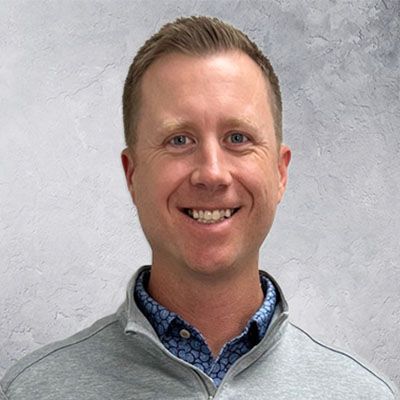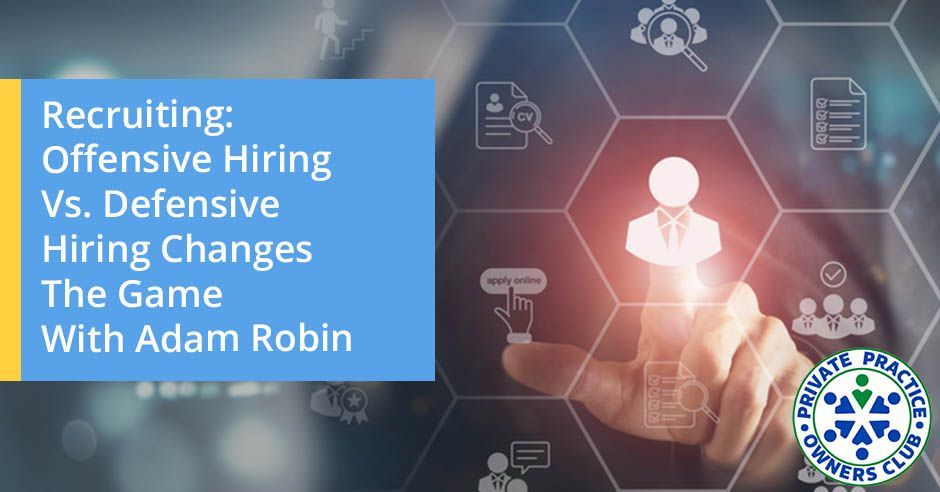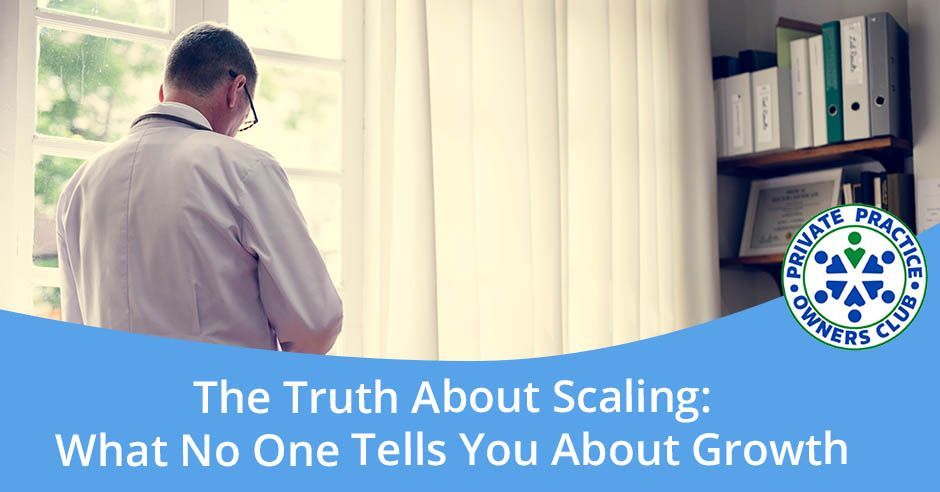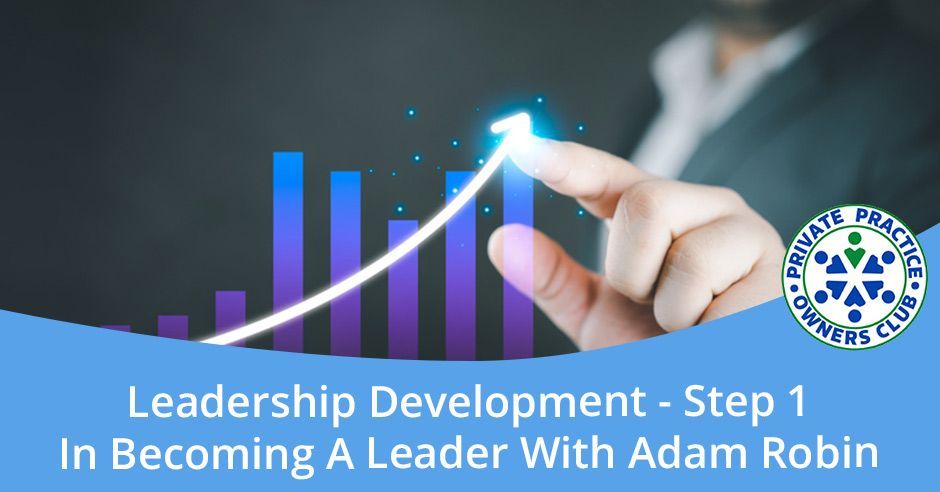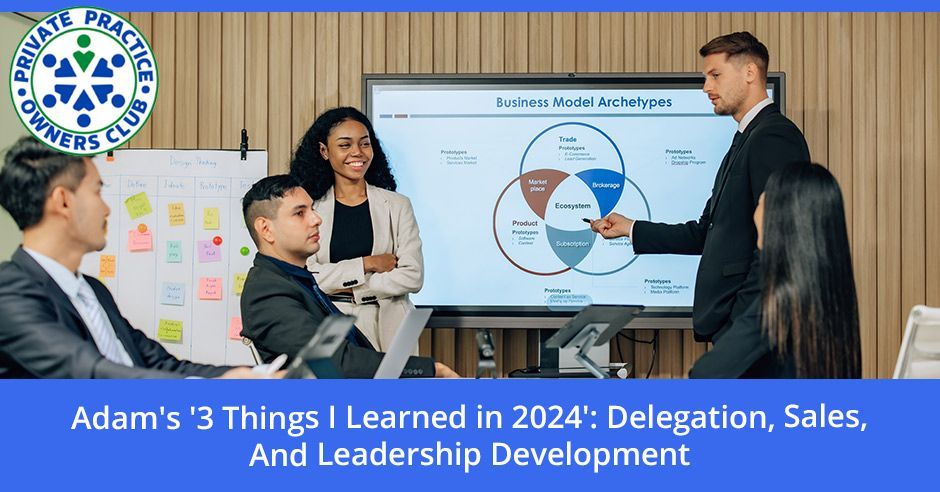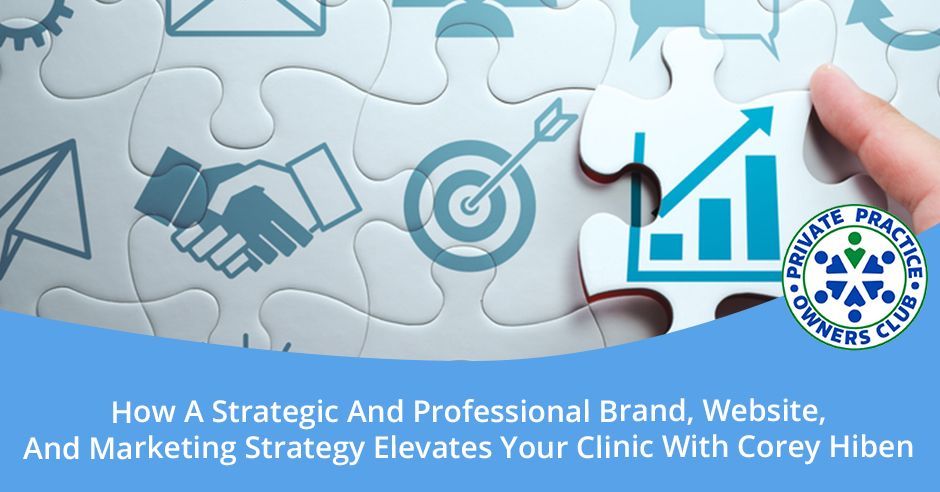From treating patients to successfully hiring PTs and preparing for a third Practice – Kenny Holder’s story proves that breaking free from burnout is possible.
In this episode of the Private Practice Owners Club Podcast, Kenny Holder, owner of Elite Therapy, shares his journey from feeling stuck in patient care to becoming a true CEO of his Practice.
Tune in and learn:
- Taking a bold step
- Kenny took the bold step of hiring PTs simultaneously, which led to rapid growth.
- Lead and Teach
- Through leadership development and coaching, Kenny reduced his treatment hours, giving him time to work on his Practice growth.
- Be a CEO
- Kenny’s Practice began to grow when he shifted from thinking like a PT to being an owner and CEO.
For Practice owners who are stuck in patient care or struggling to grow their Practice, Kenny’s story demonstrates that with the right mindset change, scaling your Practice is achievable.
Don't miss this episode of Private Practice Owners Club Podcast – whether you're just starting or thinking about your next step in scaling your practice, this episode is packed with wisdom for your Private Practice to succeed.
Visit our Linktree for our Coaching Services, Free KPI Dashboard, Facebook Group, and Annual Strategic Planning Services:
https://go.ppoclub.com/linktree-podcasts
Love the show? Subscribe, rate, review, and share!
https://ppoclub.com
---
Listen to the podcast here
Client Of The Month With Kenny Holder
Welcome to the show. We’ve got our client of the month,
Mr. Kenny Holder. For those that remember a couple of episodes ago, we’re going to start doing a series where once a month, we interview one of our clients and we’re going to learn about them. What I’ve recognized through doing some of this over the last few years is everybody wins a little differently. We interviewed
Sam Jackson. He’s got his story in his way. In this episode, we’re going to talk to Kenny. He’s winning, but he’s using his own Kenny sauce to move the needle in his business and make progress in his practice.
‐‐‐
I want to introduce you to
Kenny. What’s up? How are you?
I’m good. How are you?
I’m doing good. How’s your day?
It has been good. It has been busy, but that’s a good thing.
What kind of stuff have you been busy doing?
We’re still trying to get a lot of policies and stuff in place, changing some things up, like more guidance for our PTs, and working on the way we change some of our billing. I’ve worked on most of that.
That’s awesome. What I recognize whenever you say that is you’re working on the business.
I’ve gotten a lot more time to do that.
It’s cool because you play more of the CEO role. You identify the challenges that are in your business and move people to the right places. You solve the right problems so that you can set your team free to help you grow the business.
That’s the goal.
Introducing Kenny Holder
If you don’t mind, tell me a little bit about you. I’d love to know a little bit about you and your family, where you’re from, and where you live. Maybe you then want to tell me a little more about why you got into private practice and what’s really important to you about being a business owner. Tell me about you.
I am from Conway, Arkansas, which is in Central Arkansas. I’ve been here since college. That has been several years. I have a wife and two boys that are young. We started in 2013 in a small town here in Central Arkansas. I was working by myself and then eventually expanded in 2019. I opened up a second clinic and got into practice. A lot of it was that I didn’t really like the corporate world. I wanted to do my own thing and make my own rules, per se. You then realize that you’re still at the mercy of other people even though you work for yourself.
I went into PT school with the goal of owning my own practice. It was always something that I wanted to do. Eventually, my goal was to step out of treatment by the time I was about 50. I was planning on treating patients until I was 50. My retirement goals were that I could step back, run a practice, and work on retirement from there. We’ve been studying it since 2013. The goal is to keep expanding and open more practices.
You said you don’t like corporate. Tell me what you didn’t like about corporate.
I did a small stint in the hospital, in a corporate system. A lot of what I didn’t like was the nit-picky rules that didn’t really matter in our day-to-day operations. You had to jump through hoops to get anything done, approved, or this or that. Also, there was a lot less flexibility.
It’s different whenever you have a small practice and it’s owned by PTs, run by PTs, and everything’s looked through the lens of being a PT.
People appreciate that. I’ve had employees that are like, “The good thing about here is you’re a PT. You’re not trying to tell me what to do through someone else’s eyes. You understand what it’s like.”
The other thing you mentioned is, “Do my own thing.” One thing about entrepreneurs is that we’re not good employees. I tell people all the time, “I follow all the rules except for the stupid ones.”
Some days, it’d be nice to go to work, go home, and not have to worry about it, but stepping back into an employee role would be very difficult.
Career Path
It takes a little bit of a rebel to be an entrepreneur. You have to be really solution-oriented. We don’t typically thrive when there’s too much restriction or when that’s bottled up. We need to be free. We need to be creative. That’s the way that our brains work. We’re good at identifying solutions, and it’s hard to identify solutions whenever you’re put in a box. You opened your practice in 2013, and then in 2019, you opened a second clinic. From 2019 to 2024, have all your dreams come true? How have things been?
They’ve been good. Our first clinic was in a small town. It has always done its own thing. It has been easy. It was very easy. If I could open up ten of those that were that easy, I would do it tomorrow. For clinic number two, there was more competition. We went from a small town with no competition, didn’t have to do a lot of marketing, and word of mouth spread really fast to have to focus more on, “How are we going to get this off the ground? What’s the plan going to be? We’re going to have to learn how to market and how to do things differently.”
I always relate it to how in small towns like that, when you go to the grocery store, everyone that goes to a grocery store knows 80% of the people in that grocery store. They all talk to each other. When you get into larger places, you go to the grocery store and you’re trying to avoid anybody that you might know. Even the word-of-mouth stuff is harder to spread in a larger area than it is in those small towns.
When we met, which was a few years ago, tell me a little bit about where you were at in your business and then when we met or leading up to that.
I thought I had things together more than I did. I didn’t have a real solid policy in place. I didn’t have many procedures in place. Clinic number two was still struggling a little bit. I also knew that I was going to have to do something in order to get to where I wanted to be with the two clinics that I have as well as expanding from there.
I was looking to get out of treatment. I didn’t really know what that looked like at the time. I didn’t fully understand how to get there. I also didn’t understand what in the world I was going to do once I did get out. I didn’t have a good idea of where things were going. I started listening to podcasts and getting ideas from them. You reached out to me somehow some way after joining a Facebook group maybe. I don’t know.
I remember our first call a little bit. I get on those types of calls and ask people all the time, “What’s your vision? What do you want to do?” A lot of people will say, “If I had 2 or 3 therapists working for me, that would be amazing. That would be fantastic.” What you said to me was, “I’d like to open 5 or 6 clinics.” I was like, “We got us a guy.” Not everybody has that vision. It excites me whenever I hear that from other people. I had one guy tell me, “I want to go nationwide.” It was
like, “Let’s do it. That’s a mountain.” That’s one thing that I remember from you. If I can recall back, I remember you were treating 40 hours a week at least. You were in patient care.
Pretty much. I was in a transition and maybe getting half a day off here and there, but it was still a solid 36 hours a week that I was treating at that point. I didn’t have the staff not to.
Recruiting Process
Let’s talk about that. This is fun for me because I’m debriefing with you. I’m remembering some of our calls. We got stuck on recruiting for a while. Do you remember that?
Yeah.
It was like, “I can’t find a PT.”
We were stuck there for a good minute.
You were in that stage three of what we call the evolving leader. You’ve got a business, you’ve got referrals coming in the door, and financially, you’re doing okay. The house isn’t burning down and the systems are there, but you’re having a hard time flexing that leadership muscle and a hard time driving recruiting, like getting people excited about coming to work with you. Whenever you solve those two problems, you find yourself in a new capacity. Let’s talk about recruiting. Let’s talk about that because we talked about recruiting for several months. Talk me through that journey. Talk to me about why you felt like you were stuck with recruiting.
Recruiting before was an Indeed ad. I didn’t really know what else to do. I knew I could call people that I know, but my network wasn’t that big as far as PTs that I know. Most of the ones that I did know were either in practice for themselves or lived off. My recruiting strategy was an ad on Indeed. I did not get anything from Indeed ads.
Our first step was working our way through that. They told me, “Indeed’s ads are not going to work. You need to expand your network,” and this and that. It took time and quite a bit of effort. I learned that recruiting is a lot similar to marketing. You’re marketing yourself to a different group of people. You’re not going to hit one home run with an Indeed ad. You might, but the chances of it are slim. It is that you touch a lot of small points and it eventually comes together.
Nate likes to say, “Hit some singles.” There’s a lot we can unpack there. Everybody has a different viewpoint on how to move the needle. In my opinion, all the best owners, people who can grow any business, are really good at recruiting and marketing. Those are the two skills that they’re good at. My opinion is the first introduction into those worlds is you have to do way more stuff. You have to get way more volume, way more touch points, more phone calls, more text messages, and more face-to-face. You have to get into the schools. All the schools go to all the career day events. You have to get active. That’s the first challenge. If you want to teach a kid to swim, you throw them in the deep end. Before you know it, they’re like, “I’m up.” We can worry about, “Let’s make our strokes a little bit better. Let’s strategize the rest breaks.” We can build a strategy around it, but the first thing is you have to jump in the fire. I felt there was some hesitancy from you there. You were like, “I posted the job ad.” It’s like, “You got to have a way, but you got to get louder.”
I’ve changed it every 30 days. For us, reaching out enough was one of the big things. When we went to a system where we could send text messages, people responded to us a lot more through texting than they did through emails.
Write this down.
You then start talking to people. Even after I’ve hired, I’ve got a list of 2 or 3 that I could call back.
They’re ready to go, huh?
Yeah. It’s got a little bit of a pipeline, if not a lot more, of a network of people that I can reach out to and touch base with. It’s like sales. You talk to a lot of people. You have people that tell you no, but the more people you talk to, you’ll eventually have those that they like where you’re going and they commit to it.
I love that. That’s awesome. That’s really cool. You jumped in there, you started figuring it out, and then you were like, “Text messages are working. Let me do more of that.” There it was, sitting there the whole time. It’s been there for years. You had to find it. I remember when we got that. I was like, “Let’s go.”
We then had to decide, “How do we close the deal?” Do you remember that? We then started doing interviews. You had candidates who were like, “I might not stick around. I might want to move off. I’m not really sure what I want to do.” It turned into not a lead generation issue. It turned into sales. You were like, “I’m selling myself. I’m selling my culture. I’m selling who I am and I’m helping this person realize that maybe this is a good solution.” Talk us through that. What was your framework around that?
It was a lot of follow-up phone calls and a little bit of luck. It was really trying to provide the opportunity and sell the idea of growth, like, “This is where we’re going. There is potential for opportunity here versus going and finding a travel job and traveling. You may make more money in the beginning, but at the end of the day, you are setting some roots somewhere that have a future versus five years from now, you’re standing there wondering what you’re going to do next.” That did it more than anything.
It is so much better to set your roots where you can have a promising future instead of standing in one place wondering what you will do next.
I couldn’t agree more. It sounds like you shared your vision. First of all, you had a vision. You were clear on the vision and you started getting more clear on what your purpose was, what your values were, what you stood for, who you were, the type of people you really wanted to work with, and what you were being called to build.
That’s something we’ve gotten more solid on. We are a lot more purpose and value-driven than anything.
Those are all leadership skills. That’s why leadership is the bottleneck there, right?
Yeah.
That’s exactly why you don’t need to focus on that if you’re trying to get new patients in the door. That’s not your big bottleneck. It’s important but it’s not the thing that you need to solve. Did I give you a super secret formula for recruiting?
No.
Did I automate anything for you? Did I tell you, “All you have to do is outspend some money on Indeed.” Did I do any of that?
No.
What happened was Kenny Holder changed. He decided and elevated himself and created a new possibility. That’s the thing that moved the needle. Isn’t that crazy?
Yeah.
That’s awesome. I’ve always said, “The bad news is you’re the problem. The good news is you’re also the solution. You will not move the needle in recruiting until you become the person that you need to be to move the needle on recruiting.” Once you were able to see yourself in that role, you were able to show up in a much more powerful way.
We had two PTs out of the deal.
This knucklehead here, not only did he hire 1, but he hired 2 PTs and you got people in the pipeline. That’s nuts. We’re getting into a little more of the newer conversations. I remember having the conversation of, “Maybe I should hire one.” Let’s talk through that. You were like, “I want to hire one. Should I hire two? I don’t quite have the visits for two.” All that stuff, let’s talk through that. Like how did that come around?
In one office, we’ve been trying to hire a PT for a year. We had an immediate need. Through the recruiting efforts, I ended up with two that were wanting to come to work. In office two, we were getting full but we still had some room, but I knew if we kept growing, I was going to need another PT. I didn’t want that to be what kept us from growing. I knew how hard it had been to hire the first one.
It ended up that we sat down and did the math on what are the pros and cons and what are the true costs of what it’s going to take to hire this second guy. I felt like we could get there and that we could do what it took to get the business to get him hired and busy. He started already. We’re 80% of the way to getting his schedule full.
I remember at the conference in Clearwater, we were sitting on the rooftop thing on the first day and having a couple of beers. You were like, “I’m stressed out. I’ve got these two PTs. I don’t have the patients to see him. He is only treating four patients a day.” It’s so cool to see you overcome that.
We’re already trying to figure out a PRN therapist because if it keeps going, he should be full within the next month to two months completely.
Following Your Heart
What I’m hearing as I’m thinking about your journey is to pick your hard. Do you want to stay stuck in treatment for the rest of your life and do that or do you want to do the hard thing of figuring out how to fill up this practice? Pick one and have the courage to go after what you really want. What you’re really doing is gambling on you. You’re like, “If I give myself the space, put these people in position, and go all in on Fill This Practice 101, can I pull it off?”
You surround yourself with a great team. You went to the conference. We did a lot of brainstorming around how we could do that. You’ve got a coach. You went all in on it, and that’s all you needed. Look at you. You solved the problem. Once you fill this practice, guess what? There’s going to be a new problem and then we’re going to have to solve that one.
The good thing is I’m down to transitioning out of seeing my last few patients. I’m probably treating ten hours a week. What it’s allowing me to do is I have the time and the ability to focus on those things without running myself. Before, it was 5 minutes here and 10 minutes there. You might get twenty minutes. You never could get started on anything really well before it was time to go do something else. When you have more time to spend and focus on the things that matter, things happen a lot faster.
When you have more time to spend and focus on things that matter, everything will happen a lot faster.
Isn’t that crazy?
Yeah.
There is no problem you can’t solve. You got to have the time. You have to be committed to the process of stepping out of treatment and educating yourself. You got to get in the vault, study your numbers, play with it, figure it out, talk about hiring, and talk about recruiting. You have to hang out with some people who challenge the way that you think, either some type of mentor or coach. If you commit to that, you will grow. You will get better every single day, and then your business will get better every day.
It’s a scary thing to trust when you haven’t experienced that because we’re so used to like, “I got to hustle. I got to get out there and pick up the wheelbarrow. If I don’t hustle, then we don’t move.” Hustling is not going to get you there. You have to evolve. Once you evolve, then you’ll move. It’s really cool to see you level up. It’s awesome. It’s exciting. It gives me a lot of purpose. It’s what I live for. I live for that. I love seeing people win. That’s awesome.
It’s been a great journey so far, and I feel like it’s getting started. We still have plenty of things to work on. You’ve helped me get to the point where I have more than I know of what I’m going to do as I don’t treat patients. It has given me a lot more clarity in my role as an owner versus a therapist. My team can see it. There’s been a change there. They can see that your visions can come into reality once you have the time to start making them happen. They’re more involved through all the leadership training and stuff we’ve done. Even in that conference, it was like, “Let’s help me get my team more involved in helping us get things done and then they buy in more.” The atmosphere becomes better at that point too.
You can’t lose. It’s hard to lose when you have that and you have people really committed to that. I talk to not just practice owners, but I talk to vendors, digital marketing agencies, and EMRs. I network with a lot of those people. They talk to their clients and they’re all practice owners. This isn’t just coming from me. This is coming from everybody in the industry who communicates with practice owners. They’re all struggling. They’re all stuck in the business and burned out. It’s not all of them, but a big majority of them.
Getting Out Of Stuck
Why wouldn’t they be? It’s hard. Reimbursements are declining. It’s hard to recruit and hard to market. There are a lot of fears and insecurities. They’re like, “I don’t know what to do.” There’s a lot of that stuff. We’ve never been taught how to run a business in school. If you can put yourself, the old Kenny, back in the day before you are now, what type of advice would you give him or her if that person is stuck in their business? What are the bullet points you’d give him?
A) I would’ve started coaching back whenever I had started opening my practice up.
Have you seen Zack Randolph’s progress?
Yeah.
I’m jealous. He started with me three months before his clinic. It’s unreal. Start coaching. What else?
He and Sam.
Sam’s killing it.
I would’ve started coaching a lot sooner. I knew I wanted to grow and I knew what I wanted to do but there was no real vision as to how to do it. It was, “Treat patients. Let’s try to get busier. We’ll hire more therapists as we need to,” but there was no actual path on how we were going to get there. If I would’ve started that path a long time ago, then I’d probably be at 5 or 6 clinics by now anyway.
I spent too much time spinning my wheels and treating patients, doing this, doing that, and then not focusing on the actual business as a business. It took me a long time to realize, “I don’t want to have a therapy practice where I treat patients and that’s where it goes. There’s going to have to be some effort made to create an actual business around this.”
I remember thinking, “I’m going to work my fingers to the bone until I have enough money and then I’ll figure out what I’m going to do with it.” That was the business strategy. What happened was you kept working and the money never quite came. You get stuck in that repetitive lie to yourself. It’s like you’re addicted to that thing that’s never going to come true.
I was scared to death to spend any money. It took doing some things with a friend of mine on advertising and marketing. He started to change my mindset on, “Even if it costs you $10,000 and you’re going to make $15,000, it’s an extra $5,000 you didn’t have in the 1st place.” You start having some mindset shifts around that kind of thing. That was around the time I probably started listening to Nathan’s podcast. It really started shifting me toward, “I have to do something.” I was so burned out. Now, I’m coming home and I tell my wife, “I had a good day.”
Isn’t that fun? Isn’t that awesome?
Yeah.
I tell people all the time, “Fulfillment lives when you can work your butt off but still have so much fun.” You’re having fun. You’re like, “The conversations are flowing. I’m clear on my vision. I feel good about my work. I’m connected to my purpose. I’m enrolling people into my practice. I’m spending time with my family.” You’re having fun. That’s good. That’s what I live for. That’s the golden trophy for me.
Before we started together, I was really to the point of trying to figure out how to get out of physical therapy. I was like, “I can’t keep doing this. I’ve got to find something else or some other business. I’ve got to find something else I can do that will give me more fulfillment.” It was not that I didn’t like treating patients. I enjoyed it, but it got to the point where I couldn't focus my time on that.
The whole time you’re treating patients, you’re thinking about what else you need to be doing. That’s what burns you out more than anything. I don’t think any of us lose the love for helping people and treating patients. It’s the grind behind the scenes that you can’t do that. You have to think about all the other things at the same time and it becomes overwhelming.
There are two things I’d like to bring up. Number one, I had a mentor of mine tell me, “Your problems are going to be waiting for you on the other side of the fence too.” What happens is we grow a business. When we grow, things get complex. The business starts to demand, “There’s a new boss that we have to beat.”
We can’t beat him because we don’t know how to beat him. What we decide is, “I’m on level three. I got to beat the level three boss. I’m going to go over here and start back over on level one in this other industry, and then I’m going to go to level 2 and level 3.” It’s the same boss. Your problems are going to be sitting there waiting for you. You have to beat this boss. If there’s any clarity or any framework that you might get from that that’s useful for me, the path is always through, not around.
The other thing is you mentioned that you were burned out. You also mentioned that you were treating patients but you got all this other stuff in the back of your head that was calling you and pulling your attention. That is the first sign that it’s time for you to step away from treatment. Whenever you are working on somebody’s piriformis with one hand and then on the other hand you have a cell phone and you’re checking your emails, which we’ve all done, at that point, what’s happening is you are no longer aligned with your true purpose. There is a bigger purpose calling you and you’re not committing to it.
People get burned out whenever their day-to-day routine or their day-to-day work is not aligned with their true purpose because it takes courage to go after it. When you recognize, “No matter how scary it is, no matter if I don’t know what the outcome’s going to be, and no matter if anybody tells me I’m stupid, I’m going to go all in on what I really want to do. Even if it’s scary, radical, weird, or doesn’t make sense, I’m going all in and win that game.”
When we start winning that game, our life moves in the direction that we want. The business starts growing. You start making more money. Everything moves. You start surrounding yourself with people that want to help you. That’s awesome. What I wrote down is 1) Get into coaching quickly. 2) We got to work on the vision. We have to have clarity on the vision.
It’s more clear on how to get to where you want to get to. It’s having a vision but then also working on what are the steps you need to take to get to that point.
Having a vision and determining the steps you need to take to make it a reality will give you clarity on how to get to where you want to go.
Don’t be lazy with the vision. Don’t say, “I want to put some systems in place.” What systems, why, and how? What’s the product of that system? What do you need in place? How many people do you need to hire? There are a lot of things you have to figure out before you start throwing blanket statements out, right?
Yeah. That’s where I started. Even looking back, when we first started, I was like, “I got to get more systems in place.” I didn’t know what those systems were. I was like, “I know I need it but I don’t know what to do.” It’s still a work in progress but I know what we need and what’s going to make us as a company better versus knowing that I need something.
Build the company and then you can make some money, not make some money so you can build the company. That was pretty much it. You mentioned you weren’t aligned with your purpose, right?
Yeah.
If you feel yourself being pulled to something else, it’s probably time for you to start spending more time there.
It is taking action versus thinking about it.
Plans For The Future
We’re getting into Q4 of 2024. How has your vision expanded going into the rest of the year? Have you started thinking about 2025 and what that might look like for you? What are some of the big things that are on your plate that excite you?
The biggest thing is developing more leadership roles within our organization as it is. That shift has already started, but I’m getting more clear on how that looks. We did an annual strategic plan in 2023. You even told me, “Start somewhere. It doesn’t even matter. It doesn’t have to be perfect. You need to start it.” I’ve already been thinking about that for 2024. It’s going to have a lot more purpose this time than it did last.
There you go. You debrief and you learn. Every year, it gets better.
More leadership development within our structure. My goal in 2025 is we’re going to start expanding as well.
You’ll start looking into PT number three?
Yeah.
That’s fun.
It will be fun.
I’m on board. That’s great.
That’s the goal.
Episode Wrap-up
There are probably going to be some people who are inspired by your story who are reading this. I know you’re on
Facebook. You’re in the Facebook group. Would you mind if people found you? His name’s Kenny Holder. You can shoot him a DM.
I would go and talk to anybody.
How would anybody else get in touch with you if they had any questions about this?
Either that or my email. My email is
Kenny@EliteTherapyPT.com.
That sounds like a winner. If anybody has any questions, holler at Kenny. Kenny, let’s do this again in a year. Let’s see where we’re at.
It would probably be pretty interesting.
You be good. Let’s talk soon.
Thank you. I appreciate it.






